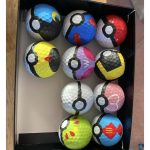Let me tell you that hundreds of thousands of questions arise when a newbie or an amateur golfer is about to play golf for the first time. At that moment, plenty of questions run through their minds. Anyway, “How many dimples are on a golf ball?” is a ubiquitous question among newcomers in the golf industry. Many of you have asked this as well. If I were to answer this question in one word, it would be 336.
However, it’s not enough to understand the whole matter in just one word. That’s because I’m going to explain in depth in this article to answer your question. Let’s move forward.
It’s impossible to provide a definitive answer to “How many dimples are on a golf ball?” The reason behind this is that it varies from ball to ball, and even from one golf ball brand to another.
It is important to note that the number of dimples on a golf ball can vary significantly depending on the specific ball and brand. Generally, the number of dimples ranges from 300 to 500. I’m going to show you some real-life examples to make it more transparent.
- Titleist Pro V1 – 388 Dimples
- Titleist Pro V1x – 348 Dimples
- Titleist AVX– 352 Dimples
- Titleist Tour Speed– 346 Dimples
- Titleist Tour Soft– 342 Dimples
- Titleist Velocity – 350 Dimples
- Titleist TruFeel– 376 Dimples
- Bridgestone Tour B X – 322 Dimples
- Bridgestone Tour B XS– 330 Dimples
Now, if you want to get more ideas, visit any golf accessories outlet so that you can be more precise about it because there is an extraordinary impact of practical knowledge in human life.
Do Dimples on a golf ball matter at all?
A golf ball consists of two parts: the inner part and the outer part. Here, the inner layer plays the primary role in making a golf ball more playable. Similarly, the outer part (the dimples) serves the ultimate purpose of making a golf ball playable.
So, does it matter how many dimples are on a golf ball if you want to become a professional golfer?
Let’s Know Why Golf Balls Have Dimples?
No golf ball manufacturer puts dimples on the balls simply because they look good. The real science behind their use is crucial. An irregular or flat object can move inconsistently through the air, so it’s easy to predict that a ball without dimples would travel unpredictably through the air. Indeed, a golfer would have little control over such a ball.
When dimples are present on a golf ball, they create a thin layer of air around it, which significantly reduces drag.
However, the science of dimples works not only for golf balls but also for cars and airplanes.
Lastly, a golf ball has dimples to lift and move forward and backward. Dimples enhance this effect by providing up to 50% more lift (and sometimes even more than 50%).
How Big Are Dimples on Golf Balls?
Typically, the average depth of a golf ball’s dimples is around 0.010 inches. The size and shape of the dimples can vary from model to model. Some dimples are spherical, while others may be hexagon-shaped.
When Did Golf Balls Get Dimples?
In the mid-1800s, the innovation of dimples on golf balls occurred suddenly. The most widely used golf ball at that time was known as the gutty, first created by famous golfer Mr. Robert Adams Paterson.
Later on, as golfers noticed that dinged-up balls had more consistent flight than pristine ones, they began to appreciate this feature.
After this discovery, golfers were satisfied until further innovations emerged in the golf ball industry. A new and innovative idea was found in the early 1900s: indentations performed far better than raised protrusions. Subsequently, William Taylor, an English manufacturer, registered a patent for a dimpled golf ball design in 1905. As golf ball technology evolved gradually over time, so too did the science of dimples. In particular, dimple patterns are now tested using advanced technological equipment to create golf balls that offer greater distance and control.
Is There Any Way to Determine Whether a Golf Ball’s Dimple Pattern Is Right for You?
Yes, it is possible to determine whether a golf ball’s dimple pattern is suitable for you. To understand this, you should have at least a basic knowledge of how golf balls with dimples are made. Additionally, you need to be familiar with the basics of golf ball technology. Otherwise, it will be challenging for you to know whether a particular dimpled golf ball is right for you.
However, if you want to examine whether your golf ball’s dimple pattern is suitable for you, check the ball’s size, shape, and depth of each dimple. If you lack sufficient information, you can visit the manufacturer’s website where you typically purchase your golf balls.
How Do Dimples in Golf Balls Affect Their Flight?
It’s important to know that the dimples on a golf ball are in contact with the air for only 1/2000 of a second. Yet, during this brief period, they establish the ball’s velocity, launch angle, and enhance its spin rate. That’s why the dimples on a golf ball are very important an essential role in golf ball performance for every golfer.
Final Verdict:
Before the 1990s, the concept of dimples on golf balls was absent. However, when William Taylor, co-founder of the Taylor-Hobson company, introduced this concept to the golf industry for the first time, the idea of dimples has been gradually implemented since then.
Dimples are significant for ensuring smooth movement and flight of a golf ball. However, there are many other important factors in the golf ball industry that you should consider before heading to a golf course. Remember, we’ve already written numerous articles about golf to help you gradually become a professional golfer.
If you have additional questions related to golf ball dimples, please feel free to comment. We will respond with accurate information as soon as possible.





